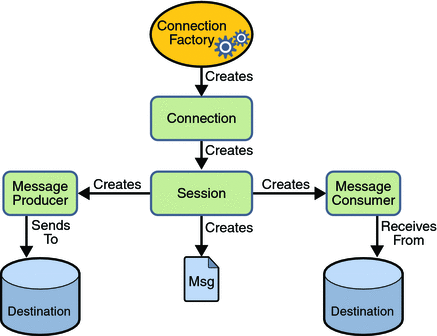A specification that describes a common way for Java programs to create,send, receive and read distributed enterprise messages.
JMS is a part of the Java Platform, Enterprise Edition, and is defined by a specification developed under the Java Community Process as
JSR 914. It is a messaging standard that allows application components based on the Java Enterprise Edition (Java EE) to create, send, receive, and read messages. It allows the communication between different components of a distributed application to be loosely coupled, reliable, and asynchronous.
Messages are
Asynchronous:
-------------
a client does not have to request them in order to receive them.
Reliable:
----------
can ensure message is delivered safely once and only once.
Messaging Domains
-----------------
Point-to-Point
 Publish/Subscribe
Publish/Subscribe
 JMS Administration With IBM WebSphere MQ
JMS Administration With IBM WebSphere MQ
-----------------------------------------------
0. Create a Queue Manager in Websphere MQ as QM1
Create a Local queue under a QM1 as LQ1
1.check the PROVIDER_URL in the C:\Program Files\IBM\WebSphere MQ\java\bin
2. Create a folder for PROVIDER_URL like (C:/JNDI-Directory)
3. execute the JMSAdmin.bat in C:\Program Files\IBM\WebSphere MQ\java\bin
4. define the queue connection Factory
define qcf(MY_QCF) qmgr(QM1)
which will create a file in the C:/JNDI-Directory as .bindings
5.create destination object
define q(MY_Q) queue(LQ1) qmgr(QM1)
which will update this details in the .bindings file in C:/JNDI-Directory
6. configure JNDI in Websphere MQ
. click on JMS Administrated Object
. right click and choose add initial context
. select File System Option
. and browse the JNDI-Directory by clicking the Browse button
. Click Next -> Finish
JMS Client
-----------

1. Initialize the InitialContext with the following values
.provide the value PROVIDER_URL
.provide the value INITIAL_CONTEXT_FACTORY
Hashtable ht = new Hashtable();
ht.put(Context.PROVIDER_URL,"file:/C:/JNDI-Directory");
ht.put(Context.INITIAL_CONTEXT_FACTORY,"com.sun.jndi.fscontext.RefFSContextFactory");
Context ctx = new InitialContext(ht);
2. Retrieve the configured QueueConnectionFactory from InitialContext by passing "MY_QCF"
QueueConnectionFactory qcf = (QueueConnectionFactory)ctx.lookup("MY_QCF");
3. Retrieve the configured Queue from InitialContext by passing "MY_Q"
Queue qu = (Queue) ctx.lookup("MY_Q");
4. Create the QueueConnection from QueueConnectionFactory
QueueConnection qcon = qcf.createQueueConnection();
5. Create the QueueSession from QueueConnection
QueueSession qsession = qcon.createQueueSession(false, Session.AUTO_ACKNOWLEDGE);
7. Create the QueueSender from QueueSession
QueueSender qSender = qsession.createSender(qu);
8. Create the Text Message from QueueSession
TextMessage msg = qsession.createTextMessage();
9. send a text throw Text Message
msg.setText(args[0]);
qSender.send(msg);
Example Sender Program
import javax.jms.*;
import java.util.Hashtable;
import javax.naming.*;
public class JMSSender
{
public static void main(String args[])
{
try
{
Hashtable ht = new Hashtable();
ht.put(Context.PROVIDER_URL,"file:/C:/JNDI-Directory");
ht.put(Context.INITIAL_CONTEXT_FACTORY,"com.sun.jndi.fscontext.RefFSContextFactory");
Context ctx = new InitialContext(ht);
QueueConnectionFactory qcf = (QueueConnectionFactory)ctx.lookup("MY_QCF");
Queue qu = (Queue) ctx.lookup("MY_Q");
QueueConnection qcon = qcf.createQueueConnection();
QueueSession qsession = qcon.createQueueSession(false, Session.AUTO_ACKNOWLEDGE);
QueueSender qSender = qsession.createSender(qu);
TextMessage msg = qsession.createTextMessage();
msg.setText(args[0]);
qSender.send(msg);
}
catch(Exception e)
{
e.printStackTrace();
}
}
}
Example Receiver Program
import javax.jms.*;
import java.util.Hashtable;
import javax.naming.*;
public class JMSReceiver
{
public static void main(String args[])
{
try
{
Hashtable ht = new Hashtable();
ht.put(Context.PROVIDER_URL,"file:/C:/JNDI-Directory");
ht.put(Context.INITIAL_CONTEXT_FACTORY,"com.sun.jndi.fscontext.RefFSContextFactory");
Context ctx = new InitialContext(ht);
QueueConnectionFactory qcf = (QueueConnectionFactory)ctx.lookup("MY_QCF");
Queue qu = (Queue) ctx.lookup("MY_Q");
QueueConnection qcon = qcf.createQueueConnection();
qcon.start();
QueueSession qsession = qcon.createQueueSession(false, Session.AUTO_ACKNOWLEDGE);
QueueReceiver qReceiver = qsession.createReceiver(qu);
TextMessage tmsg= (TextMessage) qReceiver.receive(30000);
System.out.println(tmsg.getText());
}
catch(Exception e)
{
e.printStackTrace();
}
}
}
Example Publisher Program
import javax.jms.*;
import java.util.Hashtable;
import javax.naming.*;
public class JMSPublisher
{
public static void main(String args[])
{
try
{
Hashtable ht = new Hashtable();
ht.put(Context.PROVIDER_URL,"file:/C:/JNDI-Directory");
ht.put(Context.INITIAL_CONTEXT_FACTORY,"com.sun.jndi.fscontext.RefFSContextFactory");
Context ctx = new InitialContext(ht);
TopicConnectionFactory tcf = (TopicConnectionFactory)ctx.lookup("MY_TCF");
Topic topic= (Topic ) ctx.lookup("MY_T");
TopicConnection tcon = tcf.createTopicConnection();
TopicSession tsession = tcon.createTopicSession(false, Session.AUTO_ACKNOWLEDGE);
TopicPublisher tp = tsession.createPublisher(topic);
TextMessage msg = tsession.createTextMessage();
msg.setText(args[0]);
tp.publish(msg);
tsession.close();
tcon.close();
}
catch(Exception e)
{
e.printStackTrace();
}
}
}
Example Subscriber Program
import javax.jms.*;
import java.util.Hashtable;
import javax.naming.*;
public class JMSSubscriber
{
public static void main(String args[])
{
try
{
Hashtable ht = new Hashtable();
ht.put(Context.PROVIDER_URL,"file:/C:/JNDI-Directory");
ht.put(Context.INITIAL_CONTEXT_FACTORY,"com.sun.jndi.fscontext.RefFSContextFactory");
Context ctx = new InitialContext(ht);
TopicConnectionFactory tcf = (TopicConnectionFactory)ctx.lookup("MY_TCF");
Topic topic = (Topic) ctx.lookup("MY_T");
TopicConnection tcon = tcf.createTopicConnection();
tcon.start();
TopicSession tsession = tcon.createTopicSession(false, Session.AUTO_ACKNOWLEDGE);
TopicSubscriber tSubscriber= tsession.createSubscriber(topic);
TextMessage tmsg= (TextMessage) tSubscriber.receive(3000000);
System.out.println(tmsg);
}
catch(Exception e)
{
e.printStackTrace();
}
}
}




